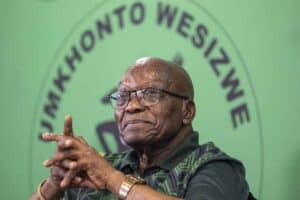A few important facts are either forgotten or ignored by increasingly rabid and racist black nationalists today.

Inside the church hall in Jan Hofmeyr, one of Johannesburg’s poorer white suburbs in 1992, the tables were groaning with food: koeksister, melktert, cooked chicken drumsticks, neat egg-salad sarmies (with the crusts cut off, Engelse style).
Round the tables the women from the National Party’s women’s organisation fussed, making everything just right as they awaited their leier, President FW de Klerk.
I walked around to the side, following a few bare-footed, raggedly dressed white children. From an open door, they were served bowls of spaghetti and bread. This was also, I discovered later, home to Tan’ Sannie se Sop Kombuis (Aunt Sannie’s soup kitchen), which fed the kids in the poverty-stricken area.
I was shocked. I had never before seen white people dependent on food handouts.
At the front, I sidled up to a foreign TV crew, who were getting a few “cutaways” as they also waited for De Klerk. They pointed their camera at a shabby young couple and asked them: What do you think of Mr De Klerk? Ja, the man said in his stumbling English, he is a good mens what wants to help our country.
When the Merc-led convoy arrived, the foreign hacks abandoned their local colour and headed for the hand-shaking head of state. I stayed within earshot of the couple.
“FW is ’n fokken verraaier (FW is a f*****g traitor),” the woman spat out with bitterness to her partner. He nodded. Ten minutes later, when the Nats departed in an important gust, I watched the couple slip in the front door of the church and grab handfuls of food. Even Nat food would keep hunger at bay.
South Africa was a strange country in those far-off days. Nelson Mandela had been released from prison two years earlier, all the former swart gevaar parties had been unbanned and negotiations about the future were under way.
De Klerk, realising he needed the support of the white electorate and whites in general behind him if he was to bring about the changes needed to avert a civil war, called for a referendum for those white voters.
The question was: “Do you support continuation of the reform process which the State President began on 2 February 1990 and which is aimed at a new Constitution through negotiation?”
When the results were announced, an overwhelming 68% of white voters agreed with De Klerk’s way forward. And that fact is either forgotten, or ignored, by the increasingly rabid and racist black nationalists out there today.
In 1992, for the first time in history, a ruling people agreed to hand over power peacefully. They accepted apartheid had to end and be replaced by black majority rule.
Africa’s most inept liberation movement, uMkhonto weSizwe, never came close to defeating the SA Defence Force on the battlefield and it was, ironically, the apolitical nature of the SADF (which remained loyal to the “government of the day” as professional soldiers) that guaranteed there would be no military coup against De Klerk or his plans.
What has happened since – from the failure to tackle poverty and sort out the land issue to the resurgence of racism from all sides – should not blind us to that critical part of our history.
Even as I hear the cries of “racist!” for saying these things, I have to wonder: without that referendum and the attitude of the SADF, where would we be now?
And the answer is simple: we would look a lot like Somalia.
Brendan Seery.
For more news your way, follow The Citizen on Facebook and Twitter.






